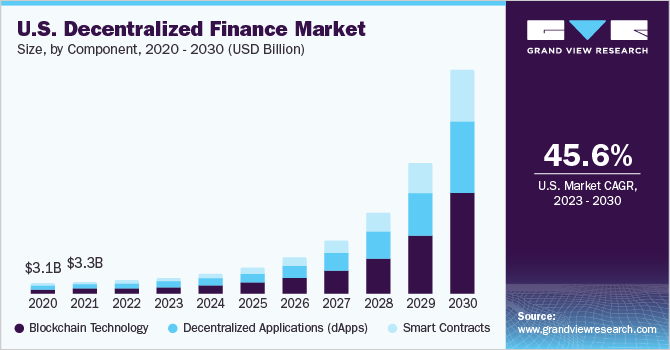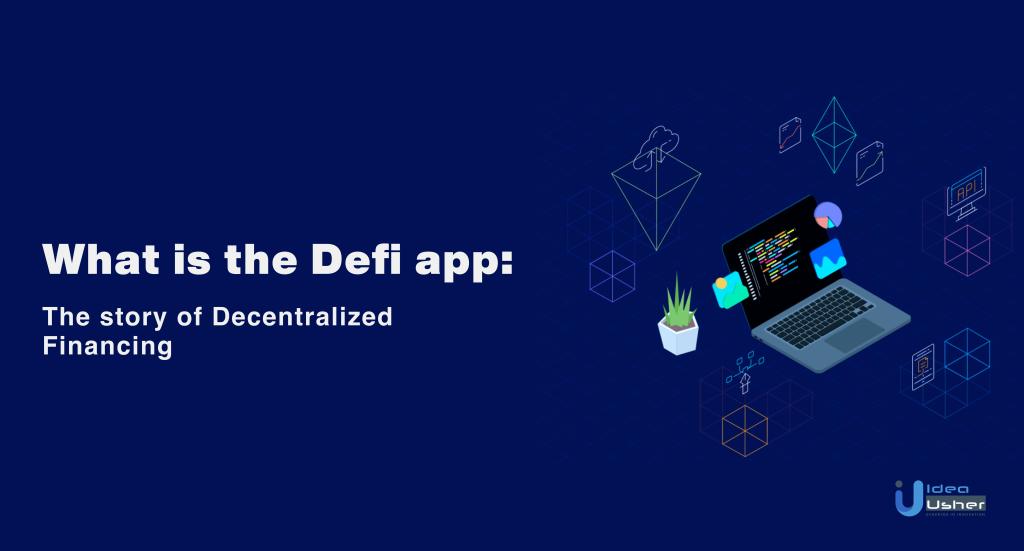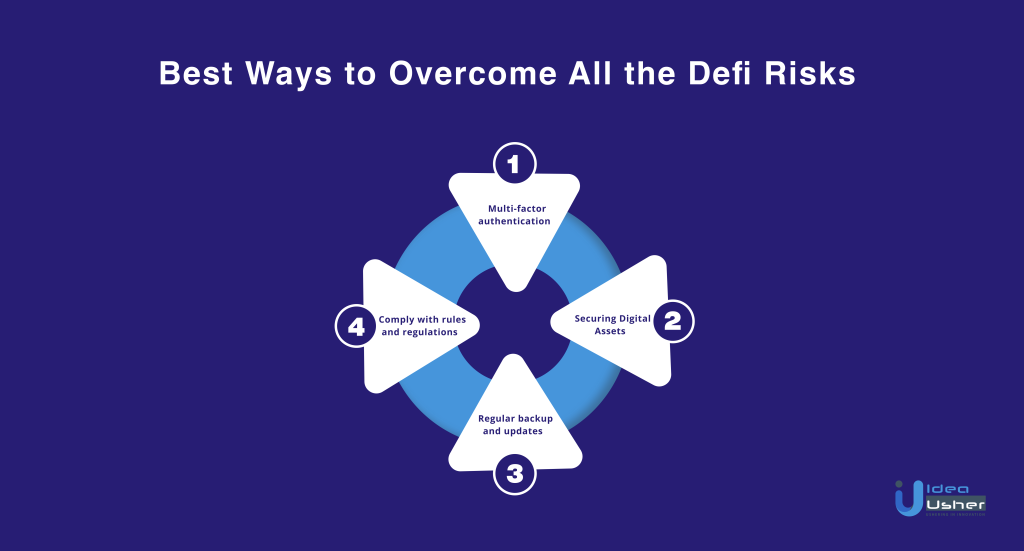the rise of Decentralized Finance, or DeFi, is reshaping the landscape of banking and investment. Picture a world where financial services are not confined within the walls of traditional institutions but are instead open to anyone with an internet connection. Welcome to the decentralized frontier, where smart contracts, blockchain innovation, and a community-driven mindset converge to redefine the way we perceive and interact with money. Join us on a journey into the heart of DeFi, as we unravel the complexities that make this financial paradigm a transformative force in the digital age
What Is the Defi Concept?
The idea of Defi resonates with the idea that every business has a future opportunity. This future opportunity can be a good investment deal for all investors.
Defi (Decentralized financing) is a decentralized financing system that allows you to finance your own business and projects. It has an internal exchange platform called DEX, where you can trade all Defi-based tokens.
Defi has two types of tokens – a utility token and a security token.
- The first one – the utility token, is a DFT token; it is a payment method in the Defi platform.
- The second one – the security token – is the FDX token. They use it as a guarantee for each loan on the platform.
How Is Defi a Decentralized Financial System?
At its core, Defi is a blockchain or distributed ledger technology (DLT) based platform that allows the creation of smart contracts. The Defi platform uses smart contracts to build decentralized applications (DApps), which are blockchain-based applications that are not under any single entity’s control.
Defi is not created by any one company or individual, but rather it is a combined effort of many different participants worldwide. Therefore, anyone can download and use the Defi platform to develop DApps.
This technology uses smart contracts to allow developers to interact with other entities on the blockchain through API calls easily. This should make it easier for developers to build decentralized applications using the Defi platform.
Defi is a decentralized financial system that eliminates the intermediaries of traditional banking. It is a platform where anyone can create their own money.
The first step in building decentralized applications using the Defi platform is to create a wallet for yourself. Once you have your wallet set up, you will start developing smart contracts and other services on top of the Defi platform.
And how does Defi work? We are going to discuss it.
First, let’s recall some interesting facts that made Defi what it is today:
Unveiling the Decentralized Finance Landscape: Market Insights and Opportunities
Revolutionizing Finance

The global decentralized finance (DeFi) market has emerged as a financial juggernaut, valued at USD 13.61 billion in 2022. Projections indicate a robust compound annual growth rate (CAGR) of 46.0% from 2023 to 2030, underscoring the transformative impact of DeFi on the financial sector. This surge is not just a numerical feat but a testament to the widespread acceptance of decentralized finance as a potent force driving market evolution.
Blockchain Integration and Popularity Surge
In recent years, the integration of DeFi with decentralized blockchain platforms has garnered immense popularity. This synergy has not only fueled market expansion but has also underscored the adaptability and resonance of DeFi within the broader financial ecosystem. The decentralized nature of blockchain technology aligns seamlessly with the principles of DeFi, creating a robust and transparent financial infrastructure.
Stripping Away Intermediaries
One of the primary catalysts propelling the adoption of decentralized finance is its ability to eliminate intermediaries from financial processes. By leveraging smart contracts and blockchain technology, DeFi empowers users to transact and engage in financial activities directly, without the need for traditional intermediaries such as banks or financial institutions. This democratization of financial processes contributes significantly to the allure of DeFi.
DeFi’s Impact on the Insurance Industry
The insurance sector stands out as a notable beneficiary of the DeFi revolution. DeFi has successfully addressed the challenges inherent in traditional insurance processes, including complex procedures, voluminous paperwork, and cumbersome audit systems. The remarkable efficiency brought about by decentralized finance platforms has streamlined operations in the insurance industry, fostering growth and innovation.
Empowering Entrepreneurs and Businesses
Beyond its impact on established sectors, DeFi presents a wealth of opportunities for entrepreneurs and businesses. The removal of intermediaries not only reduces transaction costs but also opens up new avenues for financial inclusion. Entrepreneurs can leverage decentralized finance to access capital, facilitate cross-border transactions, and engage in financial activities with greater efficiency and transparency.
Seizing the DeFi Advantage
As the global financial landscape undergoes a paradigm shift, entrepreneurs and businesses are urged to explore and integrate decentralized finance into their operations. Embracing DeFi can unlock new possibilities, enhance financial agility, and foster innovation. From streamlined transactions to increased accessibility to capital, the advantages of incorporating decentralized finance into business strategies are manifold.
What Is the Defi App: the Story of Decentralized Financing (Defi)

A decentralized finance Defi app is a platform that facilitates the peer-to-peer exchange of cryptocurrencies and other tokens.
It is the ecosystem of applications that anyone built with blockchain technology. The movement got its name from the word “defy.” They used it to connotate the meaning of “open defiance” against big banks and other financial institutions.
The term ‘Defy’ came up in August 2018. Brendan Forster of Dharma, Inje Yeo of Set Protocol, and Blake Henderson of 0x, during a Telegram chat, coined this term for the first time.
Since then, there has been no turning back for this technology. It became popular and has been growing ever since. Some reasons that made it a must for all financial institutions:
- There are no local or international borders. It is a seamless flow of data and money, thereby creating a global network.
- Codes are open for all to access and see. Anyone can open the codes and very how and where their work and money are. Therefore, this technology has been very transparent from the beginning.
- Defi protocols are heavily built on blockchains like Ethereum. These blockchains are for public use and are decentralized. It is now a community of users who participate and play equal roles in each major decision-making.
- It is a non-custodial fund management system. Therefore, there are no intermediaries or central authorities who have custody of your assets. You can hold control over their funds and wallets.
Technology used |
Blockchain technology |
| Oldest Defi project on Ethereum | Maker |
| Defi Catalyst Event | Launched COMP tokens in 2020 |
| Defi summer 2020 metrics | TVL(total value locked) rose from $800 m to 10 b |
| Big Defi platforms | Uniswap, Defizap, MakerDAO |
According to many sources, Bitcoin was not designed for smart contracts. This is why Vitalik Buterin created Ethereum in 2013. Ethereum quickly became popular with developers who wanted to build decentralized applications.
Most importantly, Ethereum was created as a more advanced platform for smart contract development. People started using it to develop various decentralized applications, including CryptoKitties, and many other financial applications.
How Does Defi Work?
The idea of decentralized financing might be foreign to you, but many people are using it every day. Peer-to-peer lending is an example of decentralized financing because it provides funding for business and personal projects without using a bank. When you take out a peer-to-peer loan, the money comes directly from the people who invest in your loan.
The borrower chooses the amount of money to borrow from the lender and the repayment period on the platform. Based on this information, they will have to pay interest over time at an agreed percentage rate.
Defi working is simple and somewhat similar o the current banking system, just more transparent and safe:
- You just stake your money on a Defi protocol instead of depositing it in a bank account.
- You have loaned your cryptocurrencies to interact with a set of smart contracts. Remember that you still own your cryptocurrencies, and you have custody of it.
- The liquidity pool was created by pledges on the protocol’s built-in smart contract. And when people take out loans on the protocol, they receive the money owed to them via crypto-backed loans.
- Pledging your crypto to a protocol can earn you interest. In return, your funds are helping the network run.
- Using this protocol, you can borrow money in crypto by pledging collateral to an individual or group.
- Each Defi smart contract is a digital contract between a borrower and a lender, with no interference from Defi. No one can temper with the contracts or the rules.
- There is a set amount of fees collected for every loan issued on the protocol.
On a general level, you find the same set of rules, protocols, and procedures for all Defi platforms.
Steps to Build Defi App:
And to make the Defi app work more clearly, let’s have a look at an effortless way to create a Defi app:
- First, you need to download and install both truffle and Ganache. Truffle is a development environment, testing framework, and asset pipeline for Ethereum, while Ganache is an Ethereum client for developing DApps.
- The second step is the creation of an ERC20 token. It’s a smart contract that has been pre-configured to issue tokens to investors in exchange for ETH. This means that all you have to do is send ETH to this contract address, and your Defi will appear in your wallet.
- Next, deploy the ERC20 token. When you deploy your ERC20 token to the Ethereum network, you will be able to receive ETH, BTC, and other cryptocurrencies for your tokens.
- The last step is to create the token contract via smart contracts, which makes your tokens.
Defi is offering a currency that has been designed around the needs of the 21st century. It is more resilient, with an algorithm that will adapt to market conditions. It became transferable from computer to computer, phone to phone, without any centralized exchange points.
What Is a Defi App?
A Defi app is a program on the Ethereum network. It enables people to interact with financial products without the need for a middleman. These products could be loans or insurance, or any other financial activity.
Defi apps use three instruments: smart contracts, Etheruem blockchain, and cryptography.
DeFi aims to make all financial services available through open-source, trustless networks. Through smart contracts, developers will build applications that offer lending and borrowing services without third-party involvement.
Some crucial aspects of Defi applications include:
- Stablecoins
- Lending and borrowing
- DEX
- Derivatives
- Insurance
- Margin Trading
To understand what each of these aspects is and how they work, click here.
Benefits of Defi Apps
In the next few years, blockchain will have a major impact on our lives. It is already in use in multiple industries, including banking and finance, real estate, healthcare, education, insurance, music, government, and more.
Decentralized financing applications are the new kid on the block. They are the emerging platform giving the incumbents a run for their money by offering better services at lower costs. Here are some of the best benefits of Defi decentralized financing apps:
Read more: Top Five DeFi Developments That Are Becoming Fast Popular!
Are There Some Risks Associated with Decentralized Financing Defi?
Yes, there are some risks associated with Decentralized financing (Defi). On the one hand, the technology of blockchain is extremely safe and secure, while on the other, some projects can be scams. Therefore, It’s crucial that you do your homework and research before investing in any new project.
Moreover, it is always a good idea to know about these risks in advance:
1. Bugs
One of the biggest risks of smart contracts is that they can have bugs. Bugs can cause all sorts of problems, like inaccurate contract executions and permanent loss of tokens.
2. Government
Decentralized finance platforms may be more difficult to block than centralized counterparts. However, the government can take action against it if a protocol violates any law or regulation.
3. Protocol shutdown
Crypto exchanges get hacked. If you use a small exchange or an exchange with no terms of service, your funds might be lost forever if the company shuts down.
4. Systemic risks
If you lock your investment in a wallet for a long time, the exchange could go out of business, which would result in you losing your investment. The best way for any investor is to get their wallet insured.
5. Network congestion and fees
The Ethereum network could be congested when there is increased demand for the cryptocurrency pair you are using. Some features of Ethereum V2 may resolve this issue by making the Ethereum network faster.
However, the demand and market cap for Defi is consistently increasing
Best Ways to Overcome All the Defi Risks

1. Multi-factor authentication
Multi-factor authentication (MFA) is a security feature that requires users to do two things; something they know and something they have. It acts as a second layer of security on top of your regular password.
When you enable multi-factor authentication, the system will require you to enter a verification code before logging in. This adds an extra layer of security because even if someone has your password, they can’t log in without the code.
2. Securing Digital Assets
When it comes to securing digital assets for investment purposes, there are two different types of storage solutions:
- hot storage,
- and cold storage.
Hot storage refers to a digital asset that is online and connected to the internet. A hot wallet provides an ideal solution for actively accessing decentralized financial services. In other words, a hot wallet is perfect for the most active users.
Cold storage refers to a digital asset that is offline and not connected to the internet. Cold wallets provide a secure way of storing a digital asset offline in a physical location that online threats cannot access. You can implement cold storage suitable via USB drives, paper wallets, or hardware wallets, etc.
In addition to securing assets from threats, hot and cold solutions also provide optimal functionality for decentralized financial services (DeFi). Hot wallets work best for users with frequent transactions who require quick access to their funds. On the other hand, cold wallets are ideal for investors who need long-term security against threats while keeping their funds offline.
There are numerous ways of protecting your digital assets from malicious agents and keeping them safe from harm—hot and cold storage solutions play a major role in DeFi security and overall user experience within the space.
3. Regular backup and updates
Smart contract developers encourage to design their contracts with the assumption of updates. As the Ethereum Foundation puts it, “An ideal smart contract system is completely general-purpose and future-proofed.” This means that you can avoid any risk associated with updating smart contracts.
There is no doubt that risks are an inevitable part of DeFi solutions. However, today’s enterprises are well equipped to address these risks with the latest updates and backups to ensure optimal performance of their operations.
4. Comply with rules and regulations
The legal aspect of the operation is also crucial. The absence of regulation poses risks for the consumers, too.
For a successful outcome, a cryptocurrency exchange should ensure compliance with rules and regulations from the government of its country and the international authorities.
Choosing the right company with the right set of people and great knowledge of Defi apps can make the best app for you. So, always make sure to check the portfolio of the company for insight into their work.
The Future of Defi: The Final Take
The Defi apps make financial processes much more effortless. For example, if you’ve ever purchased a home, you know that the process can be lengthy and often has many stages where additional information is required. To make sure you don’t forget anything, you have to make phone calls and send emails. With the Defi apps, all stages of the purchase process are kept in one place so that you can find everything you need to do quickly and easily.
Defi is also solving another problem that plagues real estate transactions: getting everyone involved with the deal on the same page. At every stage of the process, multiple people need to see critical data about the transaction — for example, property appraisals or any changes in property values. You might need this information for your own investment portfolio, but your agent may need it for other buyers interested in purchasing your property.
Defi technology will soon bring out apps that allow all parties to see updates to relevant property data so that no one is ever left waiting by phone or email for crucial information.
For more information on Defi applications and how to create one, contact us.
Build Better Solutions With Idea Usher
Professionals
Projects
FAQs
Q. Which is the best Defi Dapp in the world?
The best Defi apps are Axie Infinity, while OpenSea is also quite famous, primarily because these two have singlehandedly causing massive disruption in the market. However, a few other good apps include names like Difizap or the good old MakerDAO.
Q. What does Defi stand for in the Crypto World?
Decentralized finance, or DeFi, is an area in cryptocurrency that has been receiving huge attention. And the main goal of DeFi is to disrupt intermediaries in existing financial systems. Defi applications operate using blockchains. Some of these applications include insurance, crowdfunding, derivatives, betting bets, and loans. These are possible due to cryptocurrencies that eliminate intermediaries.
Q. Is a Defi app a feasible mobile application idea?
Yes, it is a very feasible solution for all financial activities. Additionally, you must know that Defi is still trending upward with the $15 billion mark. All you need is a good development team on a pocket-friendly budget.




















